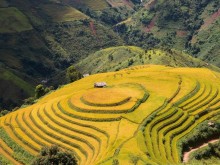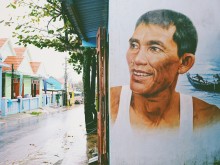Previous post: Hai Duong Travel Guide (P1)
Traditional villages
Chu Dau Pottery Village
 Chu Dau pottery village is in Thai Tan commune, Nam Sach district, Hai Duong province. Chu is a boat, and Dau is a harbour, meaning a boat parked on the riverbank. Chu Dau was originally a small village on the Thai Binh River; its reputation spread far and wide until there were traces of pottery making, reaching the pinnacle of technique and the most famous art in the world centuries ago.
Chu Dau pottery village is in Thai Tan commune, Nam Sach district, Hai Duong province. Chu is a boat, and Dau is a harbour, meaning a boat parked on the riverbank. Chu Dau was originally a small village on the Thai Binh River; its reputation spread far and wide until there were traces of pottery making, reaching the pinnacle of technique and the most famous art in the world centuries ago.
The most typical and unique products of ancient Chu Dau ceramics are the Hoa Lam vase and the Pi Ba vase, also known as the father and mother vases. The pipa vase is shaped like a pipa, representing yin nature. Mother Earth embodies the gentle and modest Vietnamese woman. The vase of blue flowers represents the positivity of being a husband, a father, a pillar and a foundation.
Dong Giao wood carving village
Dong Giao wood carving village is located in Luong Dien commune, Cam Giang district, 20km west of Hai Duong city.
 Legend has it that the wood carving profession in Dong Giao has existed for over 300 years but is gradually disappearing. By 1983, the profession was restored and developed as it is today. Dong Giao village workers are skilful, intelligent, and hard-working, so they constantly create and improve designs and their skills.
Legend has it that the wood carving profession in Dong Giao has existed for over 300 years but is gradually disappearing. By 1983, the profession was restored and developed as it is today. Dong Giao village workers are skilful, intelligent, and hard-working, so they constantly create and improve designs and their skills.
Also read: Festivals in Hai Duong are unique and interesting
Visiting the sacred Hai Duong Painting Temple ‘gets whatever you ask for ‘
Qinghai Water Puppet Village
Hai Duong has three remaining puppetry troupes: Hong Phong, Thanh Hai and Le Loi. They all take advantage of the performance venue, which is mixed with houses and fields. Thanks to that, visitors can feel close when watching.
A water pavilion was built as a performance venue in a small pond in the middle of the village. Local people cleverly evoke farm stories, often familiar with ploughing and cultivating. The four sacred dance performances and the story of the frog fisherman happened naturally and were enthusiastically responded to by visitors.
 Unlike many places, puppetry here has a different control system. If many other wards use poles to bring out the puppets and pull the strings, the people here put the poles under the water and then reconnect the strings. At that time, their skill and ingenuity will control the "character" activity and gesture.
Unlike many places, puppetry here has a different control system. If many other wards use poles to bring out the puppets and pull the strings, the people here put the poles under the water and then reconnect the strings. At that time, their skill and ingenuity will control the "character" activity and gesture.
Hai Duong people also have pottery making in Cay village (Long Xuyen commune, Binh Giang), embroidery in Xuan Neo (Hung Dao commune, Tu Ky), gold and silver making in Chau Khe (Thuc Khang commune, Binh Giang), and comb bamboo making in Hoach Trach village (Thai Hoc commune, Binh Giang), Mao Dien hat sewing profession (Cam Giang), bamboo bed making profession (Nhan Quyen commune, Binh Giang); Gai cake making (Ninh Giang), green bean cake making, Phu Loc wine making (Cam Giang), Kinh Chu stone carving (Kinh Mon)...
Folk games
Unique folk games that are maintained include artillery fire in Ninh Giang, Tu Ky, Gia Loc; kite flying in Kinh Mon; cooking rice contest in Thanh Ha; make to he in Nam Sach; beat the ground at Suo temple; Literary ceremony dance in Binh Giang...
 Among them, clay cannon is a folk game from the beginning of the year to the end of the 4th lunar month. Artillery matches between villages are often held in the communal houseyard on the full moon and on the first days of every month. People believe the louder the sound of firecrackers, the better, so the villagers will have a good rainy season and harvest.
Among them, clay cannon is a folk game from the beginning of the year to the end of the 4th lunar month. Artillery matches between villages are often held in the communal houseyard on the full moon and on the first days of every month. People believe the louder the sound of firecrackers, the better, so the villagers will have a good rainy season and harvest.
Many places that preserve this cultural heritage include Minh Duc and Quang Khai communes (Tu Ky district); Nghia An, Ung Hoe, Kien Quoc (Ninh Giang district); Duc Xuong (Gia Loc district)... Hai Duong province also brings the province-wide earthen artillery competition to the Con Son - Kiep Bac Spring Festival on the 16th day of the first lunar month every year.
Specialty
Green bean cake
Regarding Hai Duong, most thoughts about delicious gifts focus on green bean cakes. This dish was born in the early 20th century, and although it does not have an eye-catching appearance, the uniquely delicious flavour of green bean cake still attracts the attention of many travellers. Ingredients for this dish include green beans, sugar, lard and grapefruit flower oil.
 Experienced growers often choose thin green beans, dry them, roast them until golden brown, then grind them into fine powder. As for the lard, fry it over low heat to avoid burning, then filter it and take only the transparent part. Mix the sugar with water, continue to filter, add grapefruit essential oil, and mix them together skillfully in the right ratio to create delicious cakes. Enjoy green bean cake, and sip another cup of tea. The bitter and astringent taste will add to the sweetness of the cake.
Experienced growers often choose thin green beans, dry them, roast them until golden brown, then grind them into fine powder. As for the lard, fry it over low heat to avoid burning, then filter it and take only the transparent part. Mix the sugar with water, continue to filter, add grapefruit essential oil, and mix them together skillfully in the right ratio to create delicious cakes. Enjoy green bean cake, and sip another cup of tea. The bitter and astringent taste will add to the sweetness of the cake.
Gai cake
Appearing in Hai Duong since the 12th century, banh gai quickly became famous far and wide and exists to this day. This simple cake is made from garden ingredients but still makes diners remember it forever. Banh gai ingredients are divided into two parts, including crust and filling. The shell only includes sticky rice and hemp leaves, while the filling contains lard, green beans, coconut and lotus seeds.

The most sophisticated way of processing is the filling. Lard is marinated with sugar to make it crispy, like pumpkin jam. Boil lotus seeds and green beans, mash and mix with lard, fresh coconut, and sugar. Banh gai is wrapped in dried banana leaves and steamed within 2 hours. Besides Gai cake, there is also gac cake, which is famous in Ninh Giang.
Thanh Ha lychee
In May and June, thousands of lychee trees are in full bloom throughout Hai Duong, especially in the Thanh Ha area. Bright red bunches of nine-coloured lychees blend in with the green foliage. Weaving into the gardens, you will enjoy the fresh air, picking bunches of ripe lychees with your hands, and feel the fragrance and cool, sweet taste on the tip of your tongue. Characteristics of Thanh Ha lychee are ripe skin with a bright red colour, flat surface, thick pulp, clear white, crispy, sweet taste and light aroma.

Rice noodles with perch
The meat of the perch is firm, soft and has a sweet taste. After being prepared, the fish is boiled, then marinated with spices and turmeric powder and stir-fried with onions and garlic. In some places, this fish meat is also fried to prevent it from falling apart when eaten with noodles.
 The broth is also important, made from fish broth with added tomatoes, pineapple... A bowl of perch vermicelli noodles is often served with water spinach or celery, water spinach, and other spices like lettuce and banana flowers.
The broth is also important, made from fish broth with added tomatoes, pineapple... A bowl of perch vermicelli noodles is often served with water spinach or celery, water spinach, and other spices like lettuce and banana flowers.
Rice paper
A characteristic of Hai Duong is soft, chewy rice paper that does not fall apart when soaked in water for a long time. People here revealed that they only use Q5 rice to have such rice paper fibres. Customers who buy this specialty can cook it into delicious dishes such as stir-frying pork, cooking with fish, chicken...
















